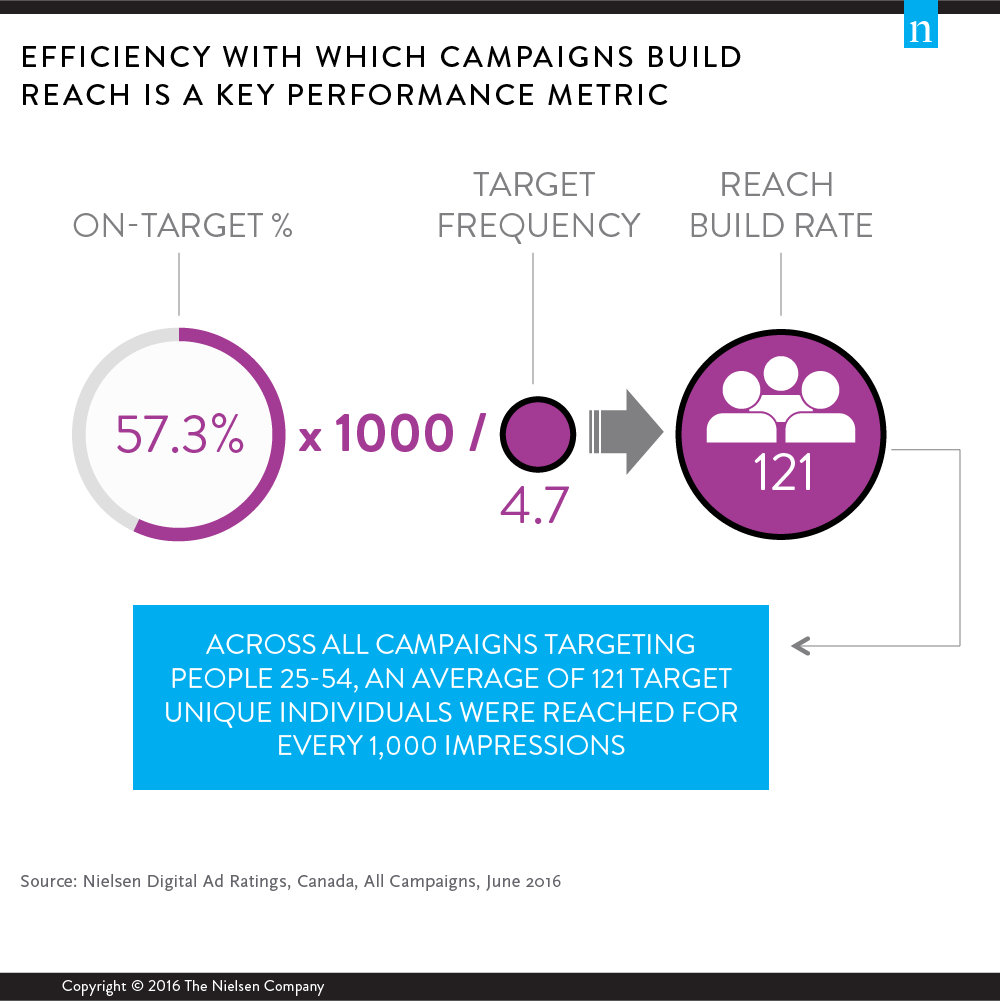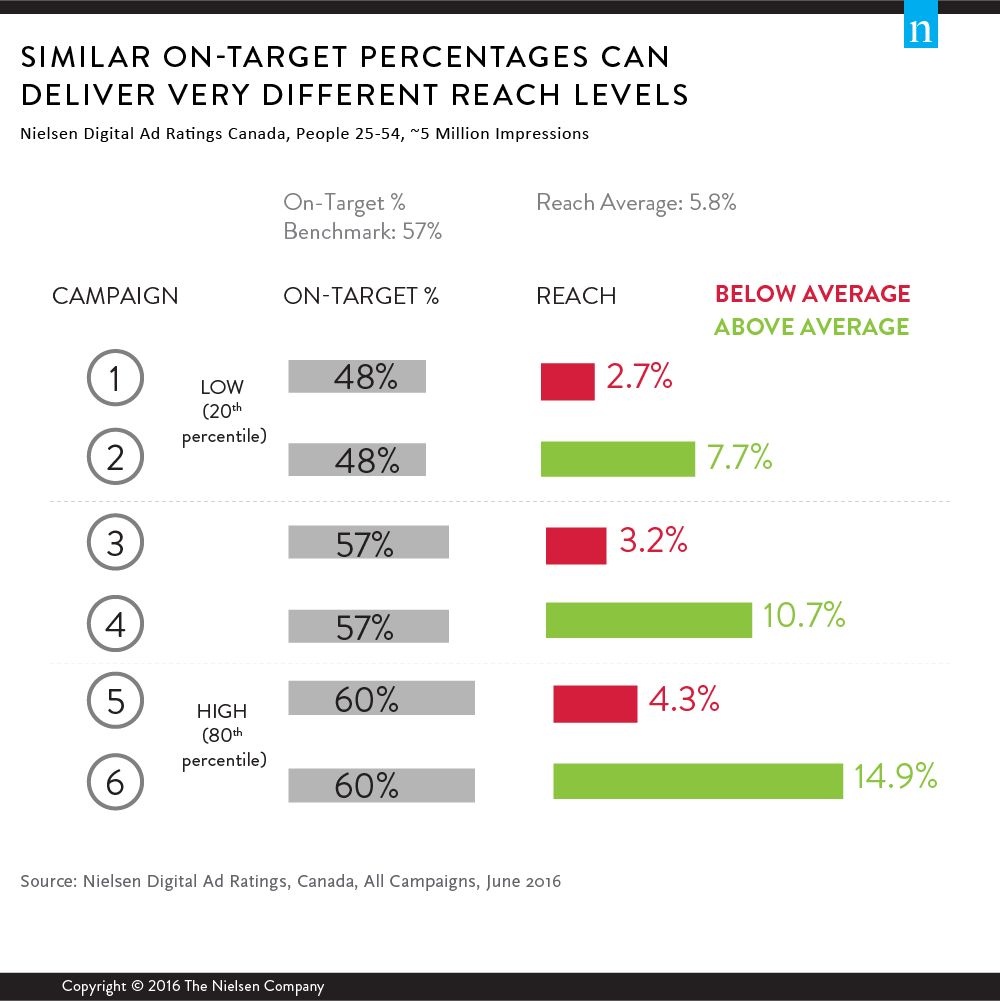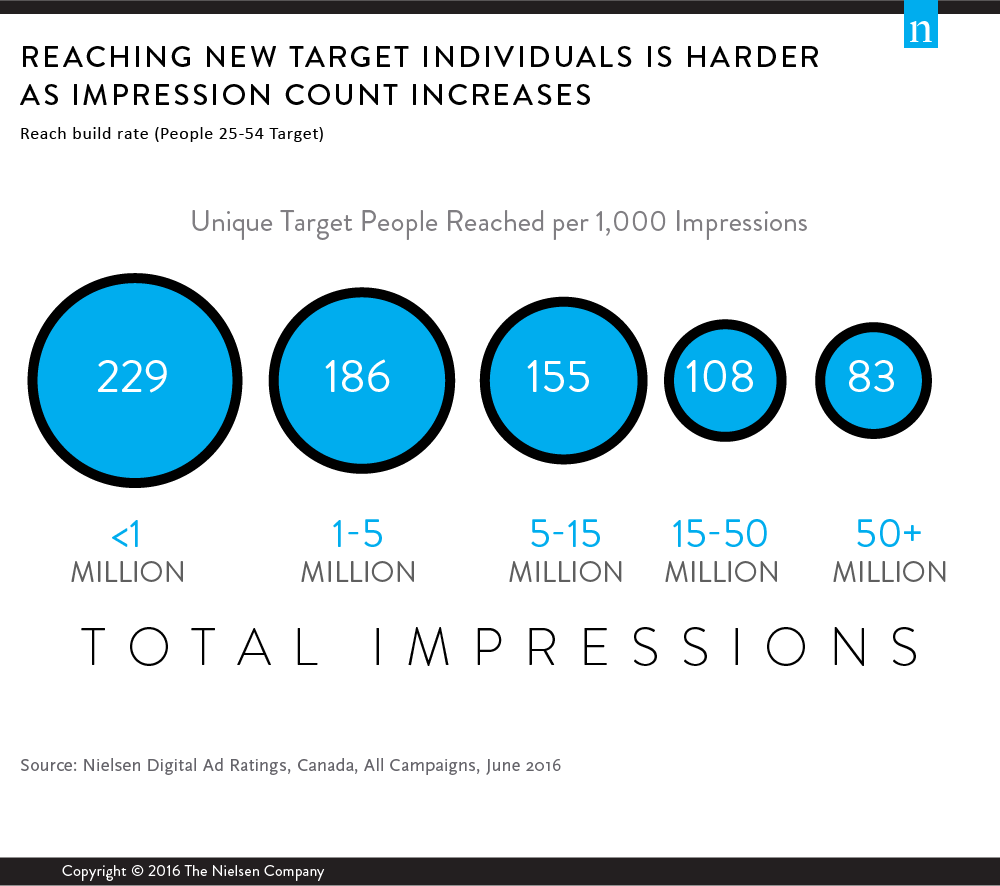Digital media buying is becoming more sophisticated as the industry moves beyond simple impression-based buying in favour of a more audience-focused approach. Today, successfully reaching the right audience first requires finding your audience across the vast digital landscape and then delivering a large percentage of your impressions to this audience. Metrics such as on-target rate provide insight into how much of a campaign’s media impressions were actually served to the right audience to ensure you aren’t wasting your media budget.
Beyond accurate reach, however, marketers have a further opportunity to better understand delivery efficiency to ensure they reach as many individuals in their intended audience as possible. By looking at the accuracy and efficiency of your audience delivery together, you can maximize the ROI of your media investment and run smarter digital campaigns.
Building smarter campaigns starts with being smarter about reach. Nielsen developed the concept of “reach efficiency” to see how efficiently media partners on a campaign reach unique people in a specific demographic group given a set media weight. We first looked at how many impressions a publisher served to the intended demographic out of their total media weight. Then, out of those impressions, we see how many of them reached unique people in that intended demographic.
Reach efficiency illustrates the difference between showing your ad 10 times to the same person versus showing your ad once to 10 different people. In Canada, for the average campaign served to adults 25-54, 121 unique people are reached for every 1,000 impressions served. Depending on your marketing goals, the number of unique people reached per 1,000 impressions may be too high or not be high enough, highlighting room for improvement.

Taking advantage of this opportunity requires understanding what works and what’s just noise. Smart digital campaigns recognize that, while precise marketing is helpful, it doesn’t automatically create more reach. We found that campaigns of similar size and on-target performance can yield very different levels of audience reach. For example, we looked at two Canadian campaigns (campaigns 3 and 4 in the chart below) that had roughly 5 million impression campaigns. They both had an on-target rate of 57%, meaning about 2.8 million impressions out of the 5 million were actually served to the intended audience. However, one campaign reached 10% of the Canadian population, translating to thousands more unique people than the other campaign that reached just 3%, just because of a more efficient media mix.

This variability in reach performance presents marketers an opportunity to double down on the parts of their media mix that work best to support a campaign’s objectives. If a campaign needs to reach as many people as possible, you want to optimize your media mix towards the publishers who have a higher reach efficiency. However, a different campaign’s goal may be to influence brand opinion, which could require audiences being exposed to an ad multiple times before having any effect. Whatever the case, understanding reach efficiency will help you diagnose campaign performance, allowing you to make an informed decision and adopt the best media mix that supports your objectives.
Despite the value of efficiency, there is a natural tendency to believe that more impressions will automatically generate more reach. In Canada, however, a recent Nielsen study found that there was no guarantee that reach would increase as campaign sizes got bigger. In an analysis of more than 20 campaigns, all with 200 target gross rating points (GRPs), total population reach varied from less than 20% on some campaigns all the way up to greater than 70% for others.
We see these results because reach can only grow so far before it experiences a point of diminishing returns. When looking at the reach build rate, or how many unique people are reached for every 1,000 impressions, we found that campaigns with less than 1 million impressions on average reach 229 unique people per 1,000 impressions. However, this decreases significantly to just 83 unique people per 1,000 impressions when the campaign size is over 50 million impressions. This illustrates the importance of being intentional in how you increase campaign size. Without a thoughtful media planning process, you could be increasing campaign size inefficiently and negatively impact your ROI.

Marketers can start to increase reach efficiency right away by first leveraging learnings from existing campaigns. Creating benchmarks around various precision marketing techniques and inventory sources from campaigns already run can help marketers understand what gives them the most reach — both in terms of how many impressions were delivered to the intended demographic group and how many unique people in that intended demographic group were reached.
In addition to looking at historical data, it’s also important to look at data in real-time to optimize against a campaign’s key performance indicators (KPIs). Publishers who see their reach build rate slow down can think about shifting delivery to other owned or operated assets, while advertisers and agencies can actively track reach build rate during the campaign and optimize media allocation. It’s also good to remember that reach is more powerful when combined with learnings about what’s resonating. By tracking reach and resonance together, you can cap the frequency of an ad’s delivery at the point when the ad’s been shown enough times to impact the most people to maximize results.
Reach efficiency means it’s no longer the biggest budgets that win. By understanding which parts of the media mix build reach the fastest at the optimal frequency, you can level the playing field and set the stage for smarter ad campaigns.



